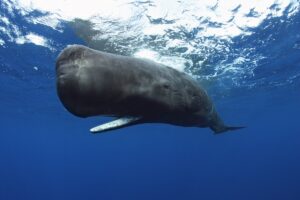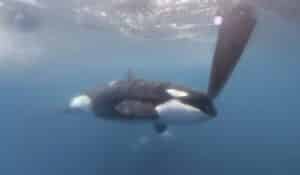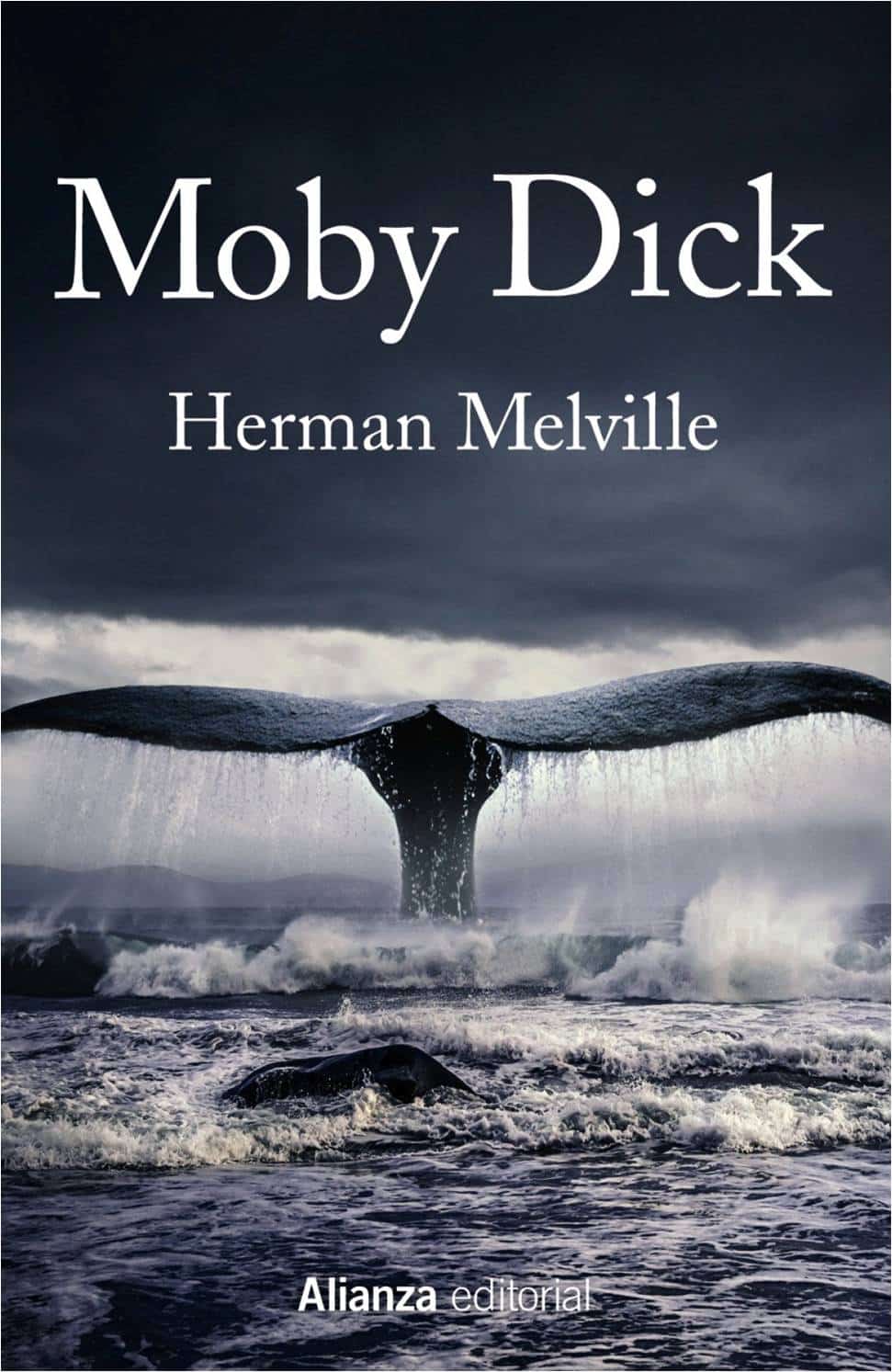Photo: Moby Dick cover (Alianza Editorial)
Moby Dick has been described as one of the most important novels of North American literature. With such information in mind, many readers have approached to this book, discovering with their reading, not only an adventure where the main character is an immense sperm whale, but a masterpiece in which Herman Melville (New York, 1819- 1891) perfectly describes the soul of whalers, and leaves us as a legacy, one of the best compilations about the whaling industry of the 19th century. Miles, storms, oceans, envy, captains,…, all are nouns that identify this wonderful work, but the story would be meaningless without the main axis of this story: Captain Ahab’s tireless fight to hunt down the great white whale, which had torn off his left leg years ago. Moby Dick was not just a simple whale, but he had distinctive signs that made him unique: a broken tail fin and a twisted mouth. In our collective imagination, this immense animal joins megalodons, leviathans, krakens and other beings that inhabit the deep ocean, turning them into monsters, which due to their destructive capacity, did not leave anyone indifferent.
To create the legend of Moby Dick, Melville uses all the experiences he lived at sea; the premature death of his father made him enlist for the first time in the New York-Liverpool maritime line. Two years later, due to the difficulty of finding stable employment, he embarked again for four years; this time on a whaleboat around the southern seas. It was all these experiences that allowed Melville to present us how whalers live onboard, but with no doubt, it was the sinking of a whale ship by a sperm whale, the story that inspired him to describe the “monster” that allow him to writte this great masterpiece. This story is detailed with great precision in the book In the Heart of the Sea, published in 2015, where the American writer Nathaniel Philbrick tells the story of the “Essex”, a whaling ship that left the North American port of Nantucket in 1819 with the mission of capturing whales and turning them into precious oil. These missions usually lasted for a period of 2 years, although in the particular case recounted in the book, they were cut short after fifteen months, when while sailing in the middle of the Pacific, the ship was attacked by an immense sperm whale, and the crew was forced to take refuge in three whaleboats approximately 8 meters long. Moby Dick contains several detailed references to the sperm whale attack, as Melville uses the words of the Essex’s first officer to describe the great white whale: “All of her oozed resentment, swift vengeance, eternal malice” before attacking the ship. Later, although in the novel the immense animal directs its attention to captain Ahab´s boat, the reality was that the immense 26-meter male sperm whale attacked the ship for the second time, leaving it completely useless.

Sperm Whale. Photo from El coloso de los siete mares in www.amuraworld.com
According to research professor Hal Whitehead, an expert in sperm whales behavior and population biology, it is possible that the sperm whale initially attacked the Essex by mistake, and that could upset the animal so much that it resulted in the second incident, which really gives the impression of being an attack. Many whalers of the 19th century thought the same, recording in their logbooks the fact that, as sperm whales hunting increased, a change in behavior was observed in the animals, “becoming more restless and skittish, and fighting back to defend themselves”. It might seem that the pressure that was being put on them was anoying, and they were learning from each other how to deal with their enemies. Indeed, whaling was not a minor activity: it is estimated that the whalers of Nantuquet and other North American ports captured 225,000 sperm whales between 1804 and 1876.
Although it is true that in general are genes and instinct those marking the behavior of animals, in marine mammals, as in human beings, it has been proven that culture plays a fundamental role , and that the teachings of adults can mark in an extraordinary way the behaviors of their offspring. In this sense, professor Whitehead has recently published an article in which he shows how sperm whales were able to adapt quickly to the pressure that the whalers were exerting on them. To do this, he analyzed the logbooks of the whaling ships, and observed that the success rate when harpooning previously sighted sperm whales fell by 58% in the first years of activity. This fact could not be explained by the competence of the harpooners, but by the fact that the sperm whales learned, in less than a decade, different defense strategies. Their ability to communicate danger to other groups with echolocation, navigate against the wind, make long dives, or stay in a group and attack – just as they do to defend themselves from orcas – were some of the causes of their success. This shows that whales learn from each other, that is, these animals have the ability to transmit culture.

Orca “playing” with the rudder of a sailing boat. This photo has been taken from a video filmed by Team Jajo during Ocean Race.
Culture and marine mammals undoubtedly leads us to talk about the increasing “attacks” of killer whales on the west coast of the Iberian Peninsula. Although our collective imagination could lead us again to think of killer whales with a high destructive capacity, the interactions that are taking place between orcas and sailboats, suggest that orcas could be following a fashion, that is rapidly being transmitted among different members of the group, and therefore, like our fashions, it can come and go. This hypothesis, supported by scientists around the world, is supported by the fact that the orcas never have aggressive behavior, but rather “playful”, as can be seen in the fantastic video recorded by the crew of a sailing ship in the vicinity of the Strait of Gibraltar. It is therefore essential that the media does not have a bad narrative that might lead to aggressive behavior towards them, which could undoubtedly aggravate the current situation. It is a fact that the number of interactions with boats increases every year, but not because they are becoming more and more annoying with us, but because, like other marine mammals, they have a high capacity to learn from each other.
With all this knowledge, perhaps we should consider where we live and with who we share natural world. It is extraordinarily important to understand these fantastic animals, because as professor Whitehead says in his fantastic Ted talk: “only by understanding how their culture affects their ecology and their evolution, we can better understand our cultures: not only what they mean, but why we have them.”
References
Books
In the heart of the sea. Nathaniel Philbrick. ISBN 978-84-672-6472-2
The cruise of the cachalot. Frank Thomas Bullen. ISBN 978-84-182-2731-8
Moby Dick. Herman Melville
Articles
Whitehead H, Smith TD, Rendell L. 2021 Adaptation of sperm whales to open-boat whalers: rapid social learning on a large scale? Biol. Lett. 17: 20210030. https://doi.org/10.1098/rsbl.2021.0030
Videos
Orcas. https://www.youtube.com/watch?feature=shared&v=E1rqcI2jULY
Whale culture: Hal Whitehead at TEDxHalifax. https://www.youtube.com/watch?v=9uyGXoMaXns


